|
Having trouble reading this email? Download the PDF. 
Thematic focus: Environmental governance, Disasters and conflictsCyclone Phailin in India: Early warning and timely actions saved lives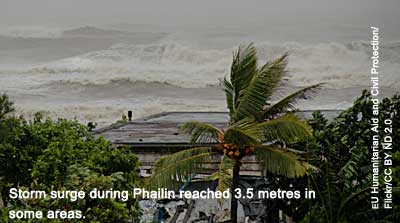
Effective disaster planning, preparation and dissemination of early warning information led to a minimal death toll in the wake of the strongest cyclone to hit India in 14 years. In mid-October, Cyclone Phailin swept over the Bay of Bengal and across the eastern coast of India, causing hundreds of millions of dollars in damage and affecting the livelihoods of 13 million people. The evacuation of more than a million people in the states of Odisha and Andhra Pradesh in response to effective early warnings resulted in a much lower death toll than a catastrophic cyclone of similar strength that struck in 1999, leaving 10,000 people dead. Continued early warning efforts could have similar positive results in the future, and when accompanied by good communication and adequate preparation, impacts of disasters could be mitigated or even prevented. This bulletin will focus on the lessons learned from Cyclone Phailin and how they can be applied to other disasters such as the recent Typhoon Haiyan. Why is this issue important?On the evening of October 12, 2013 a very severe tropical cyclone, Phailin, brought torrential downpours, damaging winds of more than 220 kilometres per hour (km/h) and storm surges of up to 3.5 metres (m) to the eastern Indian states of Odisha and Andhra Pradesh (GoO, 2013). A satellite image of Cyclone Phailin is pictured in Figure 1. The impacts of Phailin and ensuing floods affected more than 13.2 million people, left five districts of Odisha under water, and caused hundreds of millions of dollars (GoO, 2013) in damage to homes, schools, crops and the fishing industry (Froberg, 2013). However, early warning alerts, disseminated four days before Phailin struck land, allowed for the evacuation of approximately 400,000 people on or by 11 October (Senapati, 2013). Ultimately, a total of nearly 1.2 million people were evacuated (GoO, 2013), resulting in the largest evacuation operation in India in 23 years (IFRC, 2013). Early warning also allowed for the relocation of more than 30,000 animals. A total of 21 lives were lost as a result of the cyclone and an additional 23 lives due to severe flash flooding in the aftermath of the cyclone (GoO, 2013). A comparable cyclone, Cyclone 05B, hit the same area in 1999 with winds of up to 260 km/h (IFRC, 1999), but had a much more devastating outcome: more than 10,000 lives were lost (World Bank, 2013). Government cooperation, preparedness at the community level, early warning communication and lessons learned from Cyclone 05B contributed to the successful evacuation operation, effective preparation activities and impact mitigation. This event exhibits the importance, benefits and effectiveness of the use of early warning for a massive disaster. 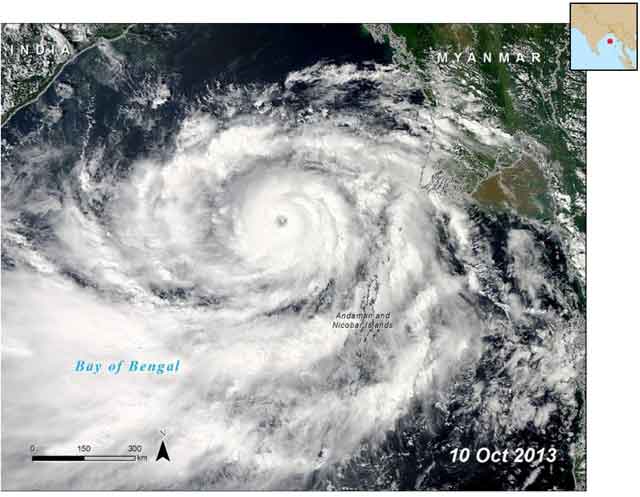
Figure 1: NASA MODIS Aqua image of Tropical Cyclone Phailin circling over the Bay of Bengal, moving west towards India, on October 10, 2013. (Credit: NASA MODIS Rapid Response Team in Gutro, 2013; visualisation by UNEP/GRID-Sioux Falls). Why is this issue important?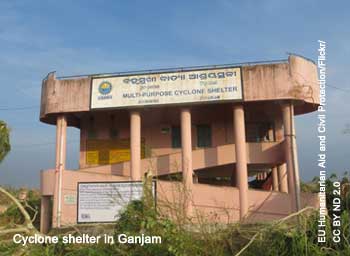
From 1970 to 2010, the Asia-Pacific population living in cyclone-prone areas increased from 71.8 million to 120.7 million, expanding the magnitude of vulnerability to disasters (ESCAP and UNISDR, 2012). However, significant improvements in disaster management, preparedness, forecasting capabilities and early warning, such as the improvements exhibited by India during Cyclone Phailin in October 2013, have helped to mitigate some disaster-related impacts. Preparedness and early warning communications and activities had been much improved since the comparable Cyclone 05B 14 years earlier (Singh, 2013). In response to Cyclone 05B in 1999, Odisha established the first state agency in India to address disaster management specifically (Odisha State Disaster Management Authority – OSDMA) (World Bank, 2013). This initiative has led to the construction of 200 new cyclone shelters, operating in places such as schools and community centres to ensure regular maintenance (Singh, 2013). Cyclone shelters have proven to be useful as 75 shelters operated by the Indian Red Cross provided safety to more than 100,000 people during Phailin (Mukherji and Agarwal, 2013) with some shelters holding up to 500 people (Froberg, 2013). Regarding forecasts, the India Meteorological Department (IMD) was able to predict wind velocity more accurately, contributing to better forecasts and more effective early warning communications (TOI, 2013). Warnings from the IMD were disseminated as early as four days before Phailin made landfall, as compared with two days of warning provided for Cyclone 05B in 1999 (Senapati, 2013). In addition to early warning alerts that prompted evacuations, precautions to protect cattle were taken and reservoirs were lowered to mitigate anticipated flooding (GoO, 2013). Also, preparedness meetings were held among various Disaster Response Teams in Odisha and volunteer teams, such as the International Federation of Red Cross (IFRC), were also on hand to assist with evacuation and relief (IFRC, 2013). 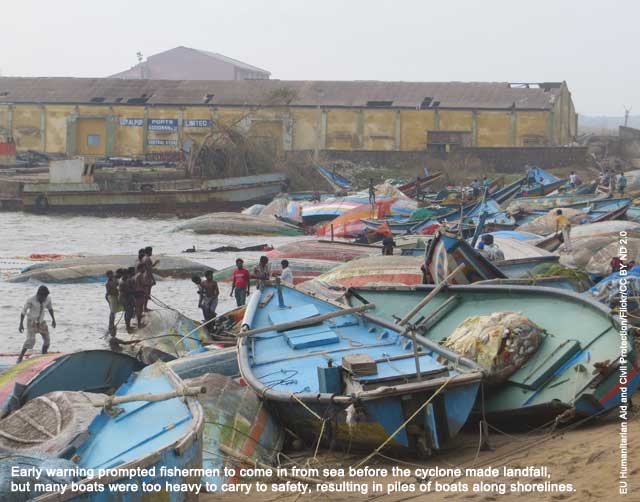
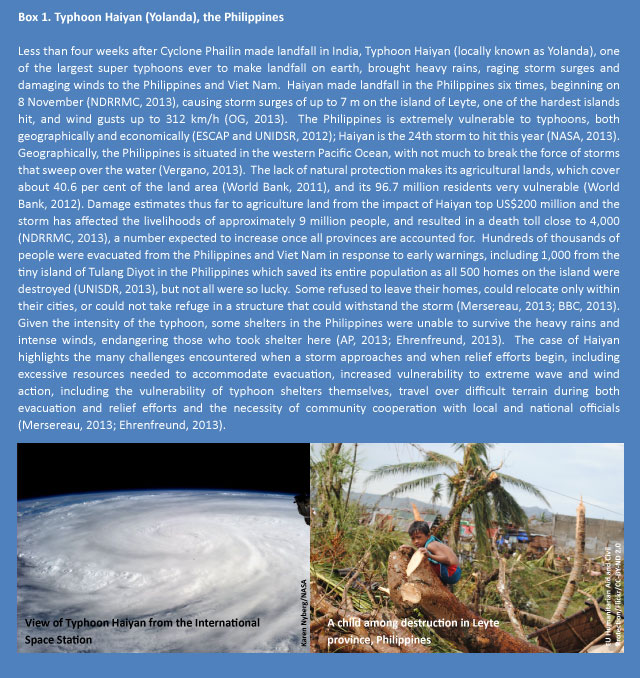
Several means of communication were exercised in the days prior to the landfall of Phailin to disperse early warning information. Different means and methods of communication are essential to reaching a large population. Examples of the means of communication included:
Benefits of early warning in coastal districts Many coastal villages bore the brunt of Cyclone Phailin’s impact. Early warning enabled coastal villages to be evacuated, especially those in Puri and Ganjam districts in Odisha. As many as 102,000 residents of Puri district and 180,000 residents of Ganjam district were evacuated (GoO, 2013). Ganjam and Puri districts were two of the few districts that received special warnings from the OSDMA on 10 October, two days before the cyclone’s landfall, to evacuate those living in mud houses and low lying areas before the morning of 12 October. According to the IMD, Puri district experienced the worst winds of the cyclone with windspeeds up to 223 km/h and received 221.6 millimetres (mm) of rain between 9 October and 14 October and its western neighbour, Khurda district, received the most rain with 273.3 mm over the same time period (GoO, 2013). 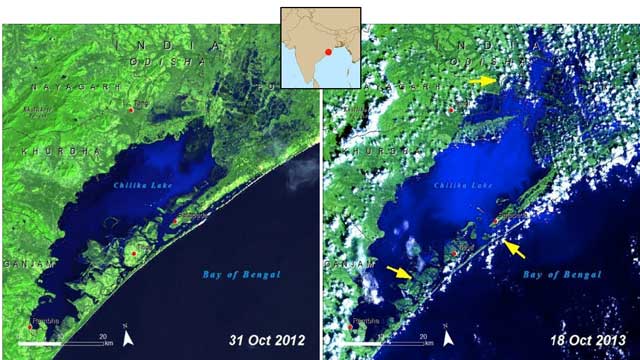
Figure 2: False-colour Landsat satellite images of Chilika Lake in 2012, when the coastline was intact, and six days after Phailin in 2013, when the coastline had been breached. Images: USGS/NASA; visualisation by UNEP/GRID-Sioux Falls. Evidence of the rainfall is exhibited by the influx of Chilika Lake, Asia’s largest brackish water lake (Barik, 2013) (Figure 2), which is bordered by Khurdha, Puri and Ganjam districts and the Bay of Bengal. Approximately 40,000 villagers who live among the islands scattered in and around Chilika were able to evacuate prior to the cyclone’s landfall, a challenging feat considering the logistics required to get from an island to the mainland (Barik, 2013). But the environment was not as fortunate. The cyclone breached the natural coastal barrier of Chilika, destroying kilometres of its delicate mangrove forests, which are favoured by some migratory species (Mohanty, 2013) and several endangered plants and animals (Chauhan, 2013). A significant proportion of casuarina forests, which served as a protective barrier for residents of the area, were buried by sand (Mohanty, 2013). Damage to Forest Department infrastructure is approximated at US$27,000 (Mohanty, 2013). Yellow arrows in Figure 2 indicate significant areas of change between the extent of the lake in October 2012 and the extent a few days after Phailin dissipated. Now that the barrier between Chilika and the Bay of Bengal has been breached, protection from future events is compromised (Mohanty, 2013), demonstrating the importance of continued early warning efforts, establishment of new damage-control mechanisms, restoration of forest ecosystems, and incorporation of ecosystem-based adaptation measures. What are the implications for policy?Globally, the number of lives lost to hydro-meteorological disasters, such as cyclones, has decreased 10 times, yet the recorded economic losses have increased 50 times (Golnaraghi et al., 2009). Golnaraghi et al. (2009) explain that the decrease in loss of life can be attributed to the formulation of policies pertaining to disaster risk reduction (DRR) and linking national and local levels to development of early warning systems (EWS), preparedness and planning. In addition, as countries continue to develop and urban growth increases, the quantity of assets exposed to disasters will increase as well (ESCAP and UNISDR, 2012). To reduce future economic loss and impacts on livelihoods, overarching DRR management plans, in conjunction with EWS, could be developed to establish medium- and long-term plans that address appropriate land use zoning, development of infrastructure and agricultural planning (WMO, n.d.). Examples of disaster risk management activities identified by the OSDMA in its Disaster Risk Reduction Programme include urban vulnerability assessment and mapping, amending building codes accordingly and increasing access to local level financial mechanisms and mitigation funds (OSDMA, 2012). Financing mechanisms such as cash transfer programmes for immediate offsets of costs, weather-related insurance and planning could also accompany these plans to help mitigate economic impact. 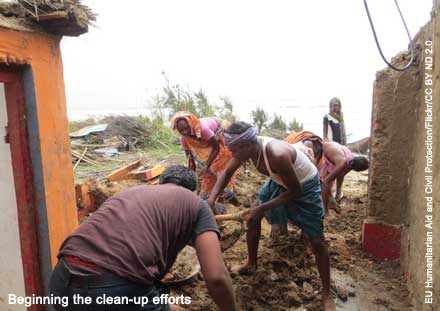
The World Meteorological Organization (WMO) regards political recognition of the benefits of developing and implementing EWS at the local and national level as one of ten principles of EWS good practice (WMO, 2011). The role of cooperation and effective communication between local and national officials was evident during Cyclone Phailin. It was reported that coordination between the local and national levels was “remarkably good,” which helped lead to successful preparedness efforts (Jain, 2013). For governments looking to emulate the collaborative approach the Indian government took, policies could be put in place to encourage participation at local and national levels for early warning communication, recovery and relief efforts. Moreover, the involvement of the community and the private sector are also essential to the establishment and implementation of prevention policy (UNISDR, 2007). The Odisha government, with support from the World Bank National Cyclone Risk Mitigation project, has spent US$255 million on increased disaster preparations including building shelters, evacuation planning, conducting drills and strengthening embankments (World Bank, 2013). Since its inception in 2011, the project has helped to increase disaster preparedness and early warning communication down to the local level (World Bank, 2013). A reported 148 additional evacuation shelters are to be built under this project and 28 were operational during Phailin (Singh, 2013). It is the World Bank’s first project in India concerning preventative disaster risk management (World Bank, 2013). However, to address the increasing economic losses that occur as a result of a disaster, in addition to development of risk management plans discussed previously, support of adequate disaster relief should accompany early warning efforts to aid in a full and speedy recovery. In the days following Phailin’s landfall, several measures were taken to jumpstart the recovery effort. The Indian Army, Navy, Air-Force, National Disaster Response Forces (NDRF) were called to action for emergency and relief efforts, helicopters distributed food rations and the Red Cross emphasized the distribution of safe drinking water as a top priority for those involved in relief efforts (IFRC, 2013). Successful and unsuccessful results of recovery efforts can be assessed by policy and decision makers when developing and improving future early warning systems and risk management plans and evaluated for effectiveness to ensure improvement to the system over time (WMO, 2011). Early warning and response activities for Phailin exhibited major improvements over those performed during Cyclone 05B in 1999 due to the evaluation and inclusion of lessons learned. Loss of lives in the case of Cyclone Phailin was minimised by effective early warning communication supported by joint efforts from the community, volunteer organisations, local and national levels of government and by donors, but also by the level of preparedness the community and local and national government exhibited. The destruction and impacts of Typhoon Haiyan demonstrate the need for the further strengthening of early warning systems in conjunction with increased preparation efforts and government and community cooperation. For both India and the Philippines, the focus is now directed to relief and recovery efforts and identifying lessons learned to reduce the impacts of future disasters that are imminent in the Asia-Pacific. AcknowledgementWriter: Lindsey Harrimana
ReferencesAP, 2013. Philippines prepared for Typhoon Haiyan, but evacuation sites couldn’t withstand storm surges. Associated Press (AP) In: The Washington Post. 11 November 2013. http://www.washingtonpost.com/world/asia_pacific/philippines-prepared-for-typhoon-haiyan-but-evacuation-sites-couldnt-withstand-storm-surges/2013/11/11/8515f684-4ac9-11e3-bf60-c1ca136ae14a_story.html (accessed 12.11.13). Barik, 2013. Residents of Chilika islands prepare for the worst. The Hindu. 12 October 2013. http://www.thehindu.com/news/national/other-states/residents-of-chilika-islands-prepare-for-the-worst/article5228792.ece (accessed 04.11.13). BBC, 2013. Severe Tropical Storm Haiyan makes landfall in Vietnam. British Broadcasting Corporation (BBC). 11 November 2013. http://www.bbc.co.uk/news/world-asia-24890114 (accessed 12.11.13). Chauhan, C., 2013. Odisha: Phailin-hit Chilika may take years to recover. Hindustan Times. 16 October 2013. http://www.hindustantimes.com/india-news/phailineyeofthestorm/odisha-phailin-hit-chilika-may-take-years-to-recover/article1-1136094.aspx (accessed 29.10.13).
Ehrenfreund, M., 2013. Evacuees in shelters were not safe as Haiyan ravaged Tacloban, the Philippines. The Washington Post. 11 November 2013. ESCAP and UNISDR, 2012. Reducing Vulnerability and Exposure to Disasters: The Asia-Pacific Disaster Report 2012. United Nations Economic and Social Committee for Asia and the Pacific (ESCAP) and United Nations Office for Disaster Risk Reduction (UNISDR), Bangkok. Froberg, M., 2013. Preparedness saved thousands of lives during Cyclone Phailin; now the recovery begins. International Federation of Red Cross and Red Crescent Societies. 17 October 2013. http://www.ifrc.org/en/news-and-media/news-stories/asia-pacific/india/recovering-from-cyclone-phailin-survivors-face-massive-hardships--63582/ (accessed 24.10.13). Golnaraghi M., Douris, J., Migraine, J., 2009. Saving Lives Through Early Warning Systems and Emergency Preparedness. Risk Wise, Tudor Rose, 137–141. GoO, 2013. Memorandum on the Very Severe Cyclone Phailin and the Subsequent Flood 12-15 October 2013. The Revenue and Disaster Management Department Government of Odisha. http://www.osdma.org/userfiles/file/MEMORANDUMPhailin.pdf (accessed 29.10.13). Gutro, R., 2013. Deadly Cyclone Phailin Makes Landfall in Eastern India. National Aeronautics and Space Administration. 18 October 2013 http://www.nasa.gov/content/goddard/phailin-northern-indian-ocean/ (accessed 24.10.13). IFRC, 1999. Cyclone: Orissa, India Information Bulletin No. 1. International Federation of Red Cross (IFRC) and Red Crescent Societies. http://www.ifrc.org/docs/appeals/rpts99/in005.pdf (accessed 30.10.13). IFRC, 2013. Disaster relief emergency fund (DREF) India: Cyclone Phailin DREF operation No. MDRIN013 14 October 2013. International Federation of Red Cross (IFRC) and Red Crescent Societies. http://www.ifrc.org/docs/Appeals/13/MDRIN0013dref.pdf (accessed 24.10.13). Jain, B., 2013. Cyclone Phailin: Superior preparedness could reduce casualties. The Times of India. 13 October 2013. http://timesofindia.indiatimes.com/india/Cyclone-Phailin-Superior-preparedness-could-reduce-casualties/articleshow/24059498.cms (accessed 24.10.13). Kumar, A.V., 2013. Cyclone Phailin hits Odisha at 200 kmph, over 7 lakh evacuated. Z News. 13 October 2013 http://zeenews.india.com/news/nation/live-cyclone-phailin-80-kms-from-gopalpur-three-dead-ahead-of-landfall_882698.html (accessed 30.10.13). Mersereau, D., 2013. Why so many people died from Haiyan and past southeast Asia typhoons. Washington Post 11 November 2013. http://www.washingtonpost.com/blogs/capital-weather-gang/wp/2013/11/11/inside-the-staggering-death-toll-from-haiyan-and-other-southeast-asia-typhoons/ (accessed 11.11.13). Mohanty, S., 2013. Phailin wipes out Chilika’s natural coastal barrier. New Indian Express. 17 October 2013. http://newindianexpress.com/states/odisha/Phailin-wipes-out-Chilikas-natural-coastal-barrier/2013/10/17/article1840156.ece?playVideo=true (accessed 29.10.13). Mukherji, B. and Agarwal, V., 2013. Early Warnings, Evacuations Saved Lives in Cyclone. The Wall Street Journal. 13 October 2013. http://online.wsj.com/news/articles/SB10001424052702304561004579132673017312350 (accessed 24.10.13). NASA, 2013. Super Typhoon Haiyan Surges Across the Philippines. Earth Observatory. National Aeronautics and Space Administration (NASA). http://earthobservatory.nasa.gov/NaturalHazards/view.php (accessed 11.11.13). NDRRMC, 2013. SitRep No. 21 Effects of Typhoon “YOLANDA” (HAIYAN). Republic of the Philippines National Disaster Risk Reduction and Management Council (NDRRMC). http://ndrrmc.gov.ph/attachments/article/1125/doc02478220131115205825.pdf (accessed 15.11.13).
OG, 2013. Status of relief and rehabilitation efforts in Yolanda-affected areas as of November 15, 2013. Official Gazette, Philippines. OSDMA, 2012. A Brief Note on GOI UNDP Disaster Risk Reduction (DRR) Programme. Odisha State Disaster Management Authority (OSDMA). http://www.osdma.org/Download/Brief_Note_10212.pdf (accessed 04.11.13). Price, G., 2013. India Survives Cyclone Phailin. Chatham House. 15 October 2013. http://www.chathamhouse.org/media/comment/view/194862 (accessed 30.10.13). Senapati, A., 2013. Mass evacuation on in coastal districts. Down to Earth. 11 October 2013. http://www.downtoearth.org.in/content/mass-evacuation-coastal-districts (accessed 24.10.13). Singh, J., 2013. How Phailin was different from super cyclone 1999. Down to Earth. 15 October 2013. http://www.downtoearth.org.in/content/how-phailin-was-different-super-cyclone-1999(accessed 24.10.13). TOI, 2013. Cheating Phailin: The calibrated approach to disaster management in Odisha and Andhra must continue to run effectively. The Times of India. 14 October 2013. http://timesofindia.indiatimes.com/home/opinion/edit-page/Cheating-Phailin-The-calibrated-approach-to-disaster-management-in-Odisha-and-Andhra-must-continue-to-run-effectively/articleshow/24105446.cms (accessed 24.10.13). UNISDR, 2007. Developing Early Warning Systems: A Checklist. United Nations Office for Disaster Risk Reduction. Third International Conference on Early Warning: From concept to action, March 27 – 29, 2006, Bonn. UNISDR, 2013. Evacuation saves whole island from Typhoon Haiyan. News Archive. United Nations Office of Disaster Risk Reduction. 15 November 2013. http://www.unisdr.org/archive/35524 (accessed 18.11.13). Vergano, D., 2013. 5 Reasons the Philippines is So Disaster Prone. National Geographic. 12 November 2013. http://news.nationalgeographic.com/news/2013/11/131111-philippines-dangers-haiyan-yolanda-death-toll-rises/(accessed 13.11.13). WMO, n.d. WMO Disaster Risk Reduction Programme. World Meteorological Organization (WMO). http://www.wmo.int/pages/prog/drr/ (accessed 04.11.13). WMO, 2011. Multi-Hazard Early Warning Systems (MHEWS). Disaster Risk Reduction (DRR) Programme. World Meteorological Organization (WMO). http://www.wmo.int/pages/prog/drr/projects/Thematic/MHEWS/MHEWS_en.html#goodpractices (accessed 04.11.13). World Bank, 2011. Data: Agricultural land (% of land area). http://data.worldbank.org/indicator/AG.LND.AGRI.ZS (accessed 13.11.13). World Bank, 2012. Data: Philippines. The World Bank. http://data.worldbank.org/country/philippines (accessed 13.11.13). World Bank, 2013. Cyclone Devastation Averted: India Weathers Phailin. The World Bank News. 17 October 2013. http://www.worldbank.org/en/news/feature/2013/10/17/india-cyclone-phailin-destruction-preparation (accessed 24.10.13).
If you no longer wish to receive this bulletin you can unsubscribe anytime. Information is regularly scanned, screened, filtered, carefully edited, and published for educational purposes. UNEP does not accept any liability or responsibility for the accuracy, completeness, or any other quality of information and data published or linked to the site. Please read our privacy policy and disclaimer for further information. |